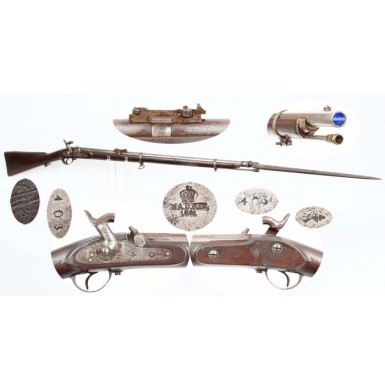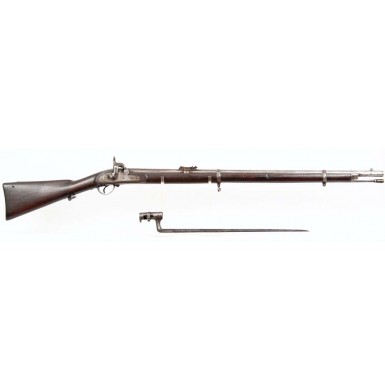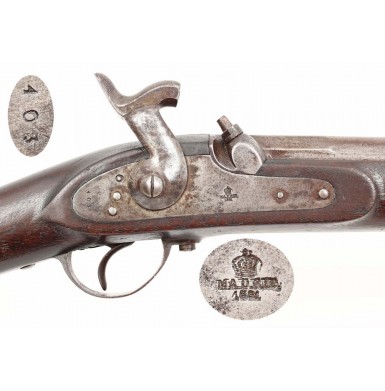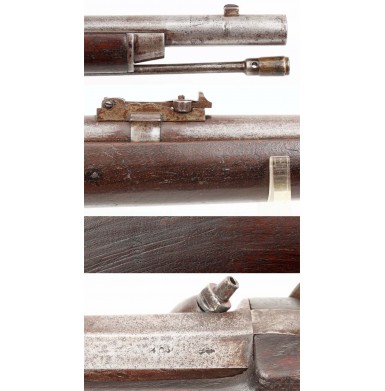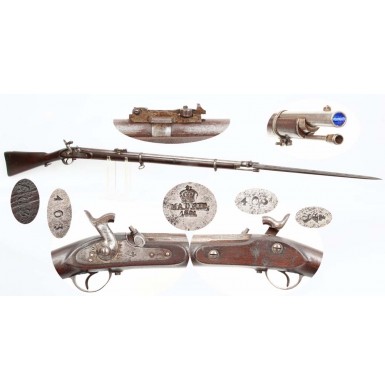Spanish M-1857 Enfield Rifle - Very Scarce
- Product Code: FLA-3066-SOLD
- Availability: Out Of Stock
-
$1.00
This is one of the rarest of the Civil War import rifles that you will ever see available for sale. It is a Spanish made copy of the British P-1856 rifle, and there is now very strong evidence that a small number of these guns really did cross the ocean and see service during the American Civil War. In his seminal work “Civil War Guns’ William Edwards classifies this rifle as being used during the war, but hypothesizes that it was used by US troops. In the best current work on Civil War used imported guns, Firearms From Europe Second Edition by Hartzler, Whisker, Yantz & Noe provide strong documentation that these may well have been purchased by the Confederate government. In a letter sent to Theodore Lewis (a CS arms purchasing agent), dated July 19, 1861 from CS agents W.G. Betterton & J.E. Chalard. 6,500 “Spanish Enfields’ were reported to be in Havana, Cuba and ready for shipment to the Confederacy at $13.00 per gun. However, the paper trail does not end there. While this letter does not confirm the importation of the guns, only the availability of them, the following is concrete evidence that at least a handful of these guns entered America, and were eventually sold as surplus by the Federal government. Whether these surplus guns were US purchases or captured CS purchases we do not know, but this new research proves beyond a shadow of a doubt that at least a few of the Spanish made the rifles made landfall in America. The following documentation comes from the National Archives, and was kindly provided to me by Civil War import arms researcher and author David Noe. All of the following comes from government publication R6 156-124, better known as Abstract of Reports of Sales of Ordnance Stores: 1864-1907. Within these reports the following listings were found for .577 Spanish Rifles:
September 27, 1880: 56 pieces were sold @ $.35 each to Francis Bannerman, all listed as "Unserviceable". (Volume 5, page 373)
October 25, 1881: 1 piece was sold to S.R. Starr for $1.00, listed as "Unserviceable". (Volume 6, page 27)
December 3, 1881: 334 pieces were sold @ $.78 each to Simon Belcher, all listed as "New & Serviceable". (Volume 6, page 38)
One other gun is listed as being sold to Charles Townsend for $1.00, also unserviceable. (Volume 6, page 217)
The information above indicates that for whatever reason, the United States government was in possession of at least 392 Spanish Enfields after the conclusion of the American Civil War. However, there is some more new evidence that helps establish even further the connection between Spanish Rifles and the Confederacy.
A number of long-time collectors and researchers have long postulated that the Confederacy received at least two batches of these Spanish rifles. The first batch in late 1861 or early 1862 has always been associated with the famous Orphan Brigade from Kentucky. The Orphan Brigade was a collection of regiments from Kentucky that were mustered into Confederate service. Because the state of Kentucky never officially joined the Confederacy, these regiments were considered “orphaned”. The brigade included the 2nd, 3rd, 4th, 5th, 6th & 9th Kentucky volunteer infantry regiments. These guns are inevitably dated 1861on the lock and have a serial number under 500 on the lock, stock and breech. The second group of rifles appears to have entered the Confederacy in late 1863 or 1864 and are 1863 dated. These guns have higher serial numbers, typically in the, mid 3,000 to mid 4,000 range. We have direct documentation of at least some of these later imports from the Official Records of the War of Rebellion. In a letter dated December 22, 1863, CS Major General Bankhead McGruder reported from his headquarters in Texas that “300 Spanish Rifles’ had been recently received. These would have likely been the 1863 dated guns that collectors encounter today. However, the O.R.’s shed little light on the earlier importation of the guns and this is what I have spent some more time researching. The association with the 1861 dated Spanish Enfields and the Orphan Brigade originated with an ID’d Spanish M-1857 rifle that is concretely attributed to a member of Colonel Hiram Hawkins 5th Kentucky infantry. Hawkins helped to establish the 5th Kentucky Infantry, CSA and eventually became the Colonel of the Regiment. Hawkins also helped to outfit the unit out of his own pocket, including the purchase of a number of imported rifles. While no history of the unit officially identifies these guns, there is much circumstantial evidence that there were a number of Spanish Enfields included in that purchase. In addition to the ID’d extant example, there have been a number of the Spanish Enfields that have surfaced in Kentucky, and typically with a strong provenance and family story of Confederate Civil War use. These guns tend to appear in two states of condition: quite good or fairly rough. This is easily explained by the fact that the original 5th KY was mustered out of service on October 20, 1862. The unit was then reformed and the original members were offered the option to go home with an honorable discharge, re-join the newly reformed 5th KY or join another of the many CS units that were being formed in Kentucky at that time. This explains the very good condition guns, as they likely went home with the soldiers who opted out (the ID’d gun in a private collection has this story associated with it). The guns of the men who stayed would show significantly more wear. The final piece of the puzzle as to why Hawkins purchased Spanish guns was recently revealed while doing some research on the Orphan Brigade “ that puzzle piece was William Preston. William Preston, who would eventually serve as the Division commander for the 5th KY, was a Kentuckian who had a long political and military service record. Preston served with distinction in the Mexican War as Lt. Col of the 4th KY volunteers. After the war he entered politics and became a very powerful and well-known Whig politician in Kentucky. When the Whig party dissolved, Preston joined the Democratic Party and threw his political support to Democratic Presidential candidate James Buchanan. After his election as President, Buchanan repaid Preston by making him the minister to Spain, and for the next few years Preston was based in Madrid, Spain. In fact, Preston was on his way back to American when the war broke out. A quick search of the Official Records shows that with the coming of the war, the Confederate government relied on Preston to help them establish contacts in Spain for the acquisition of arms. While Preston was skeptical about the availability and quality of Spanish arms, he appears to have been more that willing to help the Confederacy obtain whatever arms were available from Spain. Additional records reveal that Preston returned to the southern states via Cuba. This dovetails with the letter from Cuba and the time line works out well. All of this circumstantial evidence provides strong support for the stories about Confederate used Enfield pattern rifles that were manufactured in Spain.
The Spanish M-1857 Enfield Rifle offered here is one of those early, 1861 dated guns with a low serial number, under 500. The gun is in about FINE condition overall. The lock is smooth with a lovely pewter gray color with traces of oxidized plum brown patina, and works well on all positions. It is marked with the serial number 403 to the rear of the hammer and with the typical Spanish marks forward of the hammer: (CROWN) / MADRID / 1861, although the last “1” is almost illegible. The interior of the lock is also numbered 403. The left angled breech flat is marked with Spanish proof marks, and the matching serial number 403, which matches the one on the lock. The bottom of the breech plug tang is also numbered 403. The obverse stock is also stamped with the same number. The gun retains its very unique long-range rear sight, which is attached to the barrel by clamping, rather than being screwed or soldered. These odd sights are often missing when these rare guns are encountered today. The sight is in very good condition and fully functional. The exposed portion of the barrel retains some traces of the original blued finish, which has faded and worn, and has taken on a pewter gray patina with traces of faded blued finish that is drifting to an oxidized plum coloring. The bottom of the barrel (protected by the stock) retains about 60% of the original bright blue. The barrel is mostly smooth forward of the rear sight, with only some lightly scattered peppering and pinpricking present from the sight forward. The breech area of the rifle shows more moderate pinpricking and some light pitting, the result of the caustic wear from the mercuric percussion cap flash. The bore of the gun is in FINEcondition, and retains very crisp rifling throughout. The bore shows some light pitting scattered along its entire length, with a few scattered spots of more moderate pitting present as well. The bore measures about .577, and is nominally 25 bore, just like a typical P-1853 Enfield. The gun retains its original front swivel in its correct position on the rear most barrel band, and its original rear swivel in the toe of the stock, at the rear of the iron triggerguard tang. The rifle retains its original front sight / bayonet lug as well. The original and correct ramrod is present in the channel under the barrel. The rod is full-length, and retains fine threads at the end. It also retains the original brass band around the tip, which was intended to protect the rifling when the cartridge was rammed down the bore. The butt plate and the balance of the iron hardware have a lightly oxidized brown patina with traces of plum color to them, and show some surface pinpricking as well. The stock is in about
Overall, this is one of the nicest example of one of these rare Spanish Enfield rifles that I have ever had the opportunity to offer. I have had a total of seven Spanish Enfields in the past 12 years or so, and only three of which were the early, 1861 dated guns. This is a wonderful, unaltered and un-messed with rifle, and retains both the original rear sight and the original ramrod. Of the guns I have owned, only three others have retained the correct original ramrod. These Spanish contract rifles are a real rarity that deserve a special place of honor in any advanced collection of Civil War import arms, especially a collection that focuses on Confederate imports. The last one of these I had sold fairly quickly, so don’t you’re your chance to get one of these very scarce rifles.
SOLD
